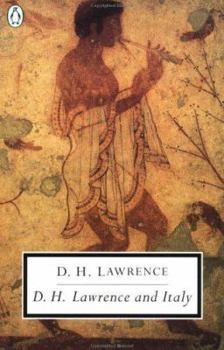D. H. Lawrence and Italy: Twilight in Italy; Sea and Sardinia; Etruscan Places
Select Format
Select Condition 
Book Overview
In these impressions of the Italian countryside, Lawrence transforms ordinary incidents into passages of intense beauty. Twilight in Italy is a vibrant account of Lawrence's stay among the people of... This description may be from another edition of this product.
Format:Paperback
Language:English
ISBN:0141180307
ISBN13:9780141180304
Release Date:July 1997
Publisher:Penguin Group
Length:115 Pages
Weight:0.80 lbs.
Dimensions:0.9" x 5.1" x 7.8"
Customer Reviews
4 ratings
Thoughtful and Beautiful
Published by Thriftbooks.com User , 18 years ago
These essays are classics. Etruscan Places almost single-handedly revived "modern" interest in the Etruscans and was essential to the preservation and study of their tombs and paintings. Throughout, Lawrence is sensitive and insightful. An added patina to these works is the fact that they were written in the 1930s during the build-up toward WWII. There is an immediacy mixed with nostalgia here that is compelling.
Over the Alps with a stolen German girlfriend...
Published by Thriftbooks.com User , 21 years ago
If i were to read only two travel books then this would be the second one, although both my wife and an English friend read it in German translation and reported that it was terrible. Maybe it doesn't translate well. Lawrence, as young man, describes a thread running through his life as he starts the journey by heading south toward Italy on foot from Bavaria with Frida, a way of travel that many Germans still understand very well. Descriptions of people are attractive, like the one-legged Italian who tried to seduce the cold, northern women at a dance. I liked best his description of his own Alpüberquerung, his description therein of the hurried English hiker, the way that Italins have ruined the alpine valleys with industrialization. And I felt loss at his growing distance from Frida. The book made me want to see the lemon and olive trees above Lago di Garda and the villages high above the lake, but we haven't done that in spite of our nearness to the region. Gardasee is completely overrun by German tourists now, not just by those wearing heavy hiking boots.
Journal of Italian travel....
Published by Thriftbooks.com User , 22 years ago
D.H. LAWRENCE AND ITALY is composed of three stories: 'Twilight in Italy', 'Sea and Sardinia' and 'Etruscan Places'. The first two "books" seem to be based on journals he wrote while traveling with his German born lover then wife Frieda, whom he refers to as q-b for queen bee, through various villages on the mainland of Italy and the island of Sardinia. Lawrence does not record his experience of "famous" sights in these two books, in fact he says he is not interested in historical places, museums etc. but rather he wishes to see the people and the places in the out-of-the way areas of Italy. He and Frieda travel by bus, train, and boat--close to the ground. Those who have read Lawrence's fiction will recognize his writing. He describes what he encounters with a visceral language--people, clothing, food, establishments. Some of the places are stunning and some so filthy you wonder how he could have stayed overnight. He visits lemon and olive groves and various high places along the coast and in the interior valleys. His writing is graphic--the reader will be as appalled and enchanted. He reflects Italy just before and after WWI.In the third book, 'Etruscan Places', Lawrence describes his visits to various Etruscan sites, including the painted tombs of Tarquinia. His writing is less descriptive than that of the first two books. He is concerned with nothing less than the meaing of life, and the conflict between religion and truth (he died a few short years later at age 44 so his reflections seem almost prescient). He muses that societies are organized around death or life. He speaks of the use of fertility symbols such as fish and lambs for Christians and dolphins and eggs for Etruscans; the significance of the color vermillion -- male body painting by warrior classes where red paint connotes power contrasted with the the red skin coloring of the Etruscan tomb portraits which seems to have connoted the blood of life. He says the Etuscans loved life and the Romans who subdued them loved power. Lawrence's book provides good background for those who would know more about Italy. Many of the places he describes have changed since the 1920s--some for the better. The people have changed--their clothing, homes, etc. are less unique and colorful, but they are better fed, warmer in winter, and cleaner. Hopefully their lives are better, but I don't think Lawrence would agree.
An extraordinary in a world... that still exist
Published by Thriftbooks.com User , 24 years ago
Had the wonderful feeling of being lost in a magic world, while reading this book. Brought to the magic island of Sardinia, on an old train, on the mountains of the island. And then, when I had the chance to be there, it all became true. The same train, the same atmosphere... in a world that did not change...after all.




